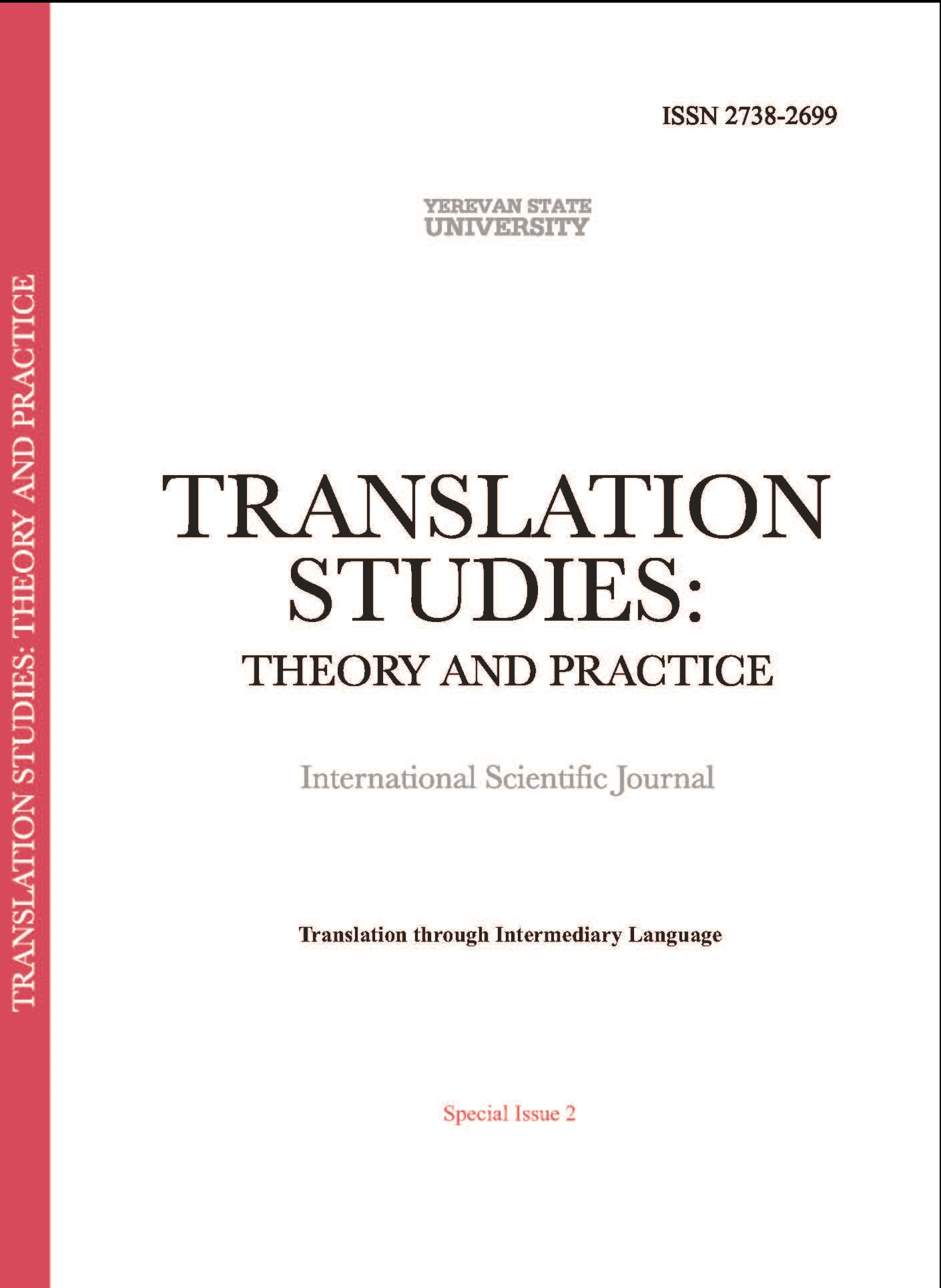Strategies of Rendering Realia in Mediated Literary Translation
DOI:
https://doi.org/10.46991/TSTP/2024.SI.2.078Keywords:
realia, mediated translation, culture-specific elements, literary translation, equivalence, translation strategyAbstract
Literary texts contain a variety of culture-specific elements requiring special background knowledge on the part of translators. In particular, the issue of realia translation poses certain challenges in mediated literary translation, as in this case the translator has to deal with transferring the source message into the target language through an intermediary text. The investigation is aimed at studying the notion of realia and identifying the strategies of their faithful conveyance in translation through an intermediary language. The findings of the article reveal that mediated translation may sometimes complicate the problem of ensuring adequate cross-cultural interaction between the writer and the reader, as the intermediary language inevitably interferes with this process leaving its imprints on the final target text. The corpus selected for this paper comprises the Russian translation of J.D. Salinger’s “The Catcher in the Rye”, the Armenian mediated translation from that Russian version and the Armenian translation from the original. The following methods have been applied in the present investigation: comparative analysis to find out similarities and differences in the translators’ application of various translation strategies, and the method of deductive research to study various transformations made in the process of translation to achieve equivalence in rendering realia.
References
Afrouz, Mahmoud. 2022. “Factors Affecting Translation of Realia in Classical Literary Masterpieces: Access to the Previous Translations, the SL Natives, and the SL Experts.” Onomázein, 56:184–205. https://doi.org/10.7764/onomazein.56.1
Aixela, Javier Franco. 1996. “Culture-Specific Items in Translation.” In Translation, Power, Subversion edited by Román Alvarez and M. Carmen-África. Clevedon: Multilingual matters Ltd, 52-79.
Denti, Olga. 2012. Cross-Cultural Representations in Tourism Discourse: The Case of the Island of Sardinia, Aipsa.
Harvey, Malcolm. 2000. A Beginner’s Course in Legal Translation: the Case of Culture-Bound Terms. Universite Lumiere Lyon 2. France.
Leppihalme, Ritva. 1997. Culture Bumps: an Empirical Approach to the Translation of Allusions. Clevedon: Multilingual Matters Ltd.
Lopatin, Vladimir. 2006. Rules of Russian Orthography and Punctuation, Moscow: Eksmo.
Newmark, Peter. 1998. More Paragraphs on Translation. Toronto: Multilingual Matters Ltd.
Nida, Eugene. 1964. Principles of Correspondence. London. Routledge.
Salinger, Jerome David. 1951. The Catcher in the Rye. Little, Brown and Company.
Salinger, Jerome David. 1960. Nad propastyu vo rzhi [The Catcher in the Rye]. Translated by Rita Wright-Kovaleva. Moscow: Inostrannaya Literatura.
Salinger, Jerome David. 1978. Tarekani Artum-Andundi Yezrin [The Catcher in the Rye]. Translated by Amalia Ghukasyan. Yerevan: Soveetakan Grogh.
Salinger, Jerome David. 2013. Prkichy Tarekani Artum [The Catcher in the Rye]. Translated by Astghik Atabekyan. Yerevan: Antares.
Semyonov, Arkady. 2013. Teoriya perevoda [Theory of Translation]. Moscow: Academia.
Timko, Natalya. 2007. Faktor “Kultura” v Perevode [Factor “Culture” in Translation], Kursk.
Tkachuk, Tatyana. 2017. “Realia Types and Strategies of Their Translation in Frames of Cultural Translation.” In Nauchni Vestnik Mezhdunarodnogo Gumanitarnogo Universiteta, Series: Philology, 30(2). Kyiv.
Tomakhin, Gennady. 1988. Realii – Amerikanizmi. Posobiye po stranovedeniyu [Realias – Americanisms. Manual of Area Studies]. Moscow: Vysshaya shkola.
Vinay, Jean-Paul. Darbelnet, Jean. 1995. Comparative Stylistics of French and English: A Methodology for Translation. Translated by Sager & Hamel. Philadelphia: John Benjamins Publishing Company.
Vlakhov, Sergey, Florin, Sider. 1980. Neperevodimoye v perevode [The Untranslatable in Translation]. Moscow: Mezhdunarodniye Otnosheniya.
Vorobyov, Vladimir. 1997. Lingvokulturologiya: Teoriya i Praktika [Linguoculture: Theory and Practice]. Moscow: RUDN PH.
Vorobyov, Vladimir. 2008. Lingvokulturologiya [Linguoculturology]. Moscow: RUDN PH.
Downloads
Published
How to Cite
Issue
Section
License
Copyright (c) 2024 Anna Khachatryan

This work is licensed under a Creative Commons Attribution-NonCommercial 4.0 International License.










